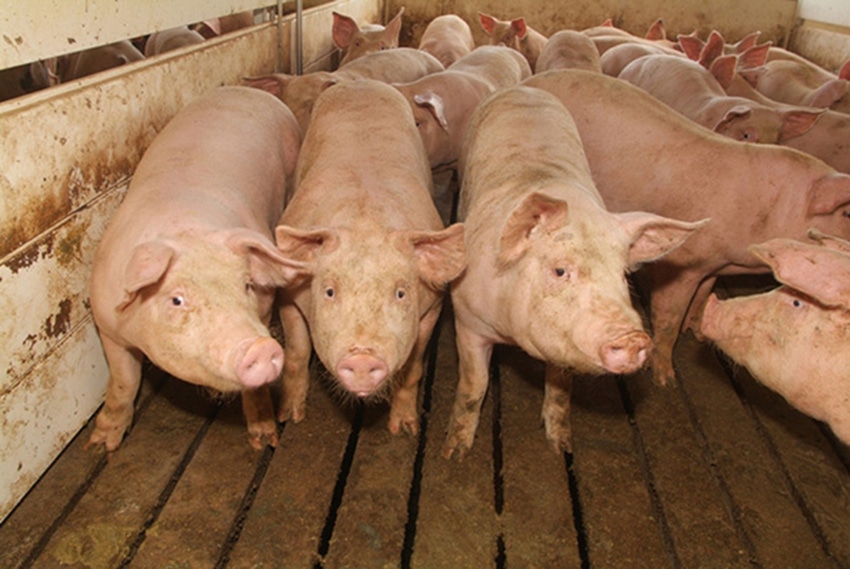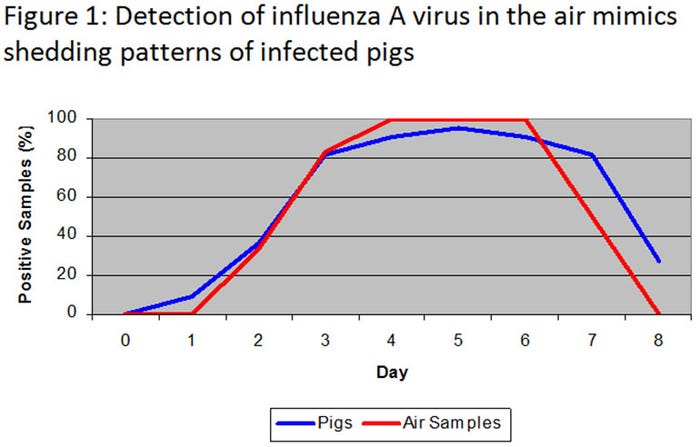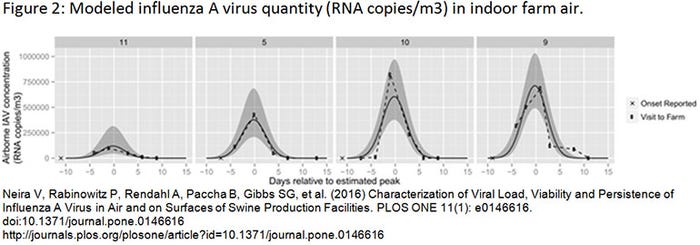Influenza can be readily found in the air and interventions to halt airborne spread of influenza should be considered to mitigate spread within farms.
December 23, 2016

By Montserrat Torremorell, University of Minnesota College of Veterinary Medicine
Influenza A virus is endemic in pigs and an on-going concern to producers. Influenza is difficult to control in part due to the multiple strains that may be co-circulating in a farm and the limited cross-protection that vaccines may offer depending on what influenza strain is in the farm.
Transmission of influenza among pigs and from pigs to people can occur via several transmission routes including direct contact, droplet and aerosol spread. While it is known that the majority of IAV transmission occurs through direct pig contact, less is known about the risk of indirect routes of transmission such as aerosols and fomites.
Our group has studied influenza aerosols extensively, both under experimental and field conditions. Influenza can be found in aerosols of pigs infected experimentally and in those cases, detection of the virus in the air mimics the nasal shedding pattern in the pigs (Figure 1) (Corzo et al., 2013). Influenza can also be detected and isolated in air samples collected in farms, agricultural fairs and animal markets. In farms, influenza can be isolated inside the barn in multiple locations which poses the intriguing question about what role aerosols play in the spread of influenza within farms. During outbreaks in growing pigs, influenza can be detected in the air for approximately three weeks (Figure 2) (Neira et al., 2016). The quantity of virus in the air appears to vary between farms and factors such as level of immunity, type of strain or number of pigs may influence that. Interestingly, duration of detection was similar across the four farms where we studied persistence of the virus in the air.
Influenza can also be isolated immediately outside the farm by the exhaust fans. Although we have detected influenza genetic material at distant locations from farms (~ 1 mile) the question still remains whether airborne transmission plays a significant role in the transmission of influenza between farms.
The investigations we conducted in the face of the H5N2 outbreaks of high-pathogenic avian influenza in the Midwest may also shed some answers. In those investigations, H5N2 virus was isolated from the air in samples collected at the exhaust fans but also at about 100 m even in conditions not conducive to virus viability (daytime and relatively warm temperatures) (Torremorell et al., 2016). More interestingly the airborne route played a significant role in the deposition of particles on surfaces outside the farm. Therefore, we speculated that both the direct transport of airborne particles between farms and the contamination of surfaces outside the facilities as a direct result of the exposure to airborne particles may play a role on the spread of influenza viruses between farms. This is particularly important if these surfaces are vehicles or equipment that may move between farms.
Another aspect to consider when studying the transport of airborne viruses is the size of particles that the viruses associate with when they are airborne. Airborne viruses travel associated with particles and this association will influence the distance the particles (and associated viruses) are transported, the location of deposition within the respiratory tract after inhalation, and the survivability and infectivity of the viruses in aerosols.
In our studies, we found airborne influenza associated to a wide range of particle sizes. However, virus viability appeared to be particle size dependent and within the range of sizes that particles can penetrate the respiratory tract potentially infecting susceptible hosts. The information derived from these studies is important to design effective airborne disease control programs, including mitigation of occupational exposure to people in contact with infected swine and poultry.
In summary, influenza can be readily found in the air and interventions to halt airborne spread of influenza should be considered to mitigate spread within farms. Although we lack evidence of influenza spread between farms through the airborne route, interventions that are used for porcine reproductive and respiratory syndrome virus such as air filtration, should also be effective to decrease the risk of influenza infections. Also important is the use of personal protective measures to prevent infections in people given the zoonotic nature of the swine influenza viruses, and those measures should include devices that block the transmission of particles of the respiratory range.


References
1. Corzo C, Romagosa A, Gramer M, Dee S, Morrison R, Torremorell M (2013). Relationship between airborne detection of influenza A virus and the number of infected pigs. The Veterinary Journal. 196(2):171-175.
2. Neira V, Rabinowitz P, Rendahl A, Paccha B, Gibbs SG, Torremorell M (2016). Characterization of viral load, viability and persistence of influenza A virus in air and on surfaces of swine production facilities. PlosOne. 11(1): e0146616. doi:10.1371/ journal.pone.0146616
3. Torremorell M, Alonso C, Davies P, Raynor PC, Patnayak D, Torchetti MK, McCluskey B (2016). Investigation into the airborne dissemination of H5N2 highly pathogenic avian influenza virus during the 2015 spring outbreaks in the Midwestern U.S. Avian Diseases 60:637-643.
You May Also Like



